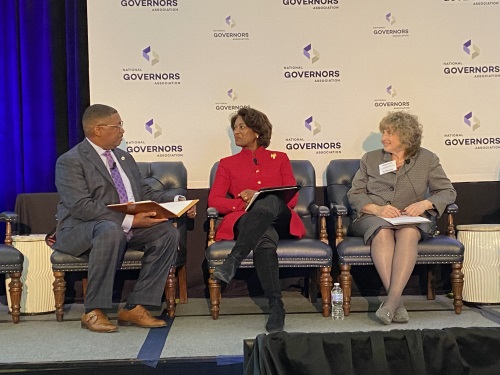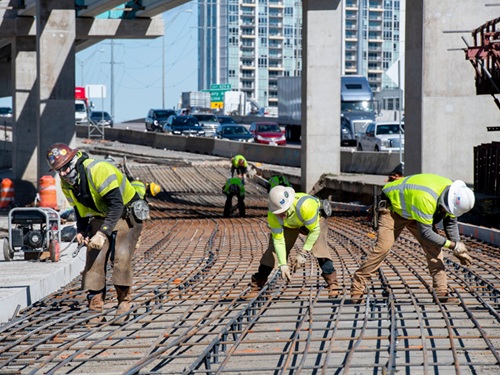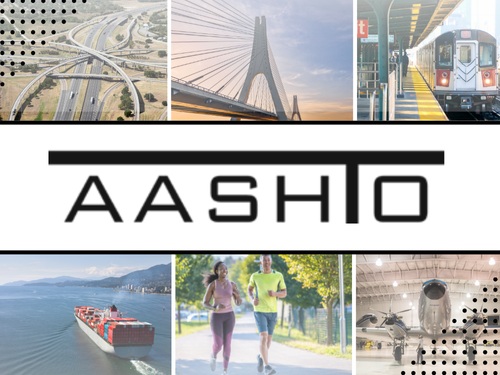During a three-day infrastructure summit hosted by the National Governor’s Association in Annapolis, MD, federal modal leaders outlined their priorities for the funding expected to flow from the $1.2 trillion Infrastructure Investment and Jobs Act or IIJA.
[Above left to right: Louisiana DOTD’s Dr. Shawn Wilson, FTA’s Nuria Fernandez, and FHWA’s Stephanie Pollack]
Nuria Fernandez, administrator of the Federal Transit Administration, and Stephanie Pollack, deputy administrator of the Federal Highway Administration, both stressed during a panel discussion moderated by Dr. Shawn Wilson – secretary of the Louisiana Department of Transportation and Development – at the summit that the IIJA provides an “opportunity to do amazing things” for the nation’s transportation network as a whole.

Dr. Wilson – who also serves as the 2021-2022 president of the American Association of State Highway and Transportation Officials – observed that safety is at the forefront of the initiatives FTA and FHWA plan to pursue with IIJA funds.
“Safety and transportation go hand in hand. It’s our north star,” explained FTA’s Fernandez. “Safety has to be at the forefront. Our overall focus is to protect [transit] operators, riders, and the public, which includes drivers, bicyclists, and pedestrians. We’re also looking to ‘harmonize’ our definitions of safety and look for ways to leverage funding to support safety investments.”

“We need to bake safety into every single [transportation] project,” FHWA’s Pollack added. “We need to ask, ‘Could this road be safer?’ We should be asking that question about every project we undertake. Speed limit setting is also very important. That is part of a national roadway safety strategy we have under development right now, which seeks to help bend the [roadway] fatality trend curve.”
Dr. Wilson also asked both leaders about how they plan to integrate equity – one of his major emphasis areas as AASHTO’s 2021-2022 president – into their agency’s transportation strategies.
“We view equity as a three-way partnership between federal agencies and state and local governments,” explained FHWA’s Pollack. “We need to do a better job partnering with local government. We need to think not only about assets that states own but also assets that localities own. We can do something now—this is an opportunity to engage with communities. We have been bad neighbors and we can fix that now.”
She also noted that the physical process of building infrastructure also offers equity opportunities.
“Who is going to build all this new infrastructure? The construction workforce is not very diverse but we can do something to change that by making more local hires,” Pollack noted. “We need to aggressively set goals. FHWA is going to be moving a ton of cash over next five years and if you increase the DBE [disadvantaged business enterprise] goals, that will increase the diversity in companies doing this work and benefiting from these [infrastructure] investments.”

“Equity is important and we take it very seriously,” added FTA’s Fernandez. “With transit, we look at the ADA [Americans with Disabilities Act]. Funding remains available but there are legacy transit systems with stations that are not accessible – those need to be improved. This very fact is an equity problem. We also need to eliminate ‘transit deserts,’ which can end up stranding the public at home. Transit agencies need to think about fixing transit deserts, where their [train and bus] lines are and if they make sense. We need to serve people where they are.”
FHWA’s Pollack that solving equity and safety issues means a broader “reimagining” of transportation is necessary.
“People do not think in modes and do not act in modes,” she explained. “Sometimes they drive, sometimes they walk, etc. A lot of state DOTs are ahead of USDOT [U.S. Department of Transportation] in this way of thinking. So let’s all put our heads together. FHWA and FTA have joint planning guidance [because] the hardest thing to do is to combine money from various modes. There are buckets of money available now that allow use across modes – such as for carbon reduction programs, as an example. We need to make it easier to use the money to do what you need to do across modes.”



